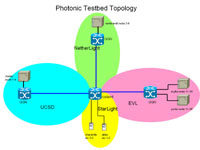AR-PIN / PDC
September 1st, 2003 - Ongoing
Categories: MS / PhD Thesis, Networking, Software

About
Grid is a computing architecture that consists of distributed clusters of computers interconnected by a network. Grid computing is used in a variety of data and compute-intensive scientific domains such as bioscience, nanotechnology, geoscience, high-energy physics. To facilitate the transportation of enormous (e.g. terabyte-sized) data-sets between Grid clusters, a Grid computing architecture, called the LambdaGrid, has emerged. LambdaGrids are Grids that are interconnected by ultra-high-speed networks that can be directly controlled by applications. Typically the unit of control is a light path (often called a Lambda) in an optical network. In order for data-intensive applications to function efficiently, they need to be able to reserve enough bandwidth, through the allocation of these light paths. This project focuses on the problem of efficient scheduling of light paths between Grid clusters. Prior approaches use rigid scheduling schemes - i.e. resources are scheduled in terms of when the resources are needed and for how long. This research focuses upon a flexible advance scheduling model to provide better overall resource utilization and user experience than a rigid scheduling scheme.
The Flexible Advance Reservation Model (FARM) is applied to the cross-domain lightpath reservation problem by incorporating Routing and Wavelength Assignment algorithms. The outcome is a coordinated Interdomain and Intradomain optical control plane called AR-PIN / PDC, which is capable of flexible advance reservations, and provides web services. The simulation results show that by relaxing the reservation time constraint, the acceptance rate and resource utilization can be improved dramatically. Also through simulations, the impact of advance reservations on immediate reservations are analyzed. The AR-PIN / PDC software has been deployed in an international photonic testbed consisting of four domains. Over the testbed, the components of end-to-end signaling latency during inter-domain reservation and claim processes are measured. The results of this research show that the major latency component during claim processes is the optical switching time; domain level parallelism can effectively reduce the claim latency, and the time slot granularity is the major factor affecting the reservation latency.